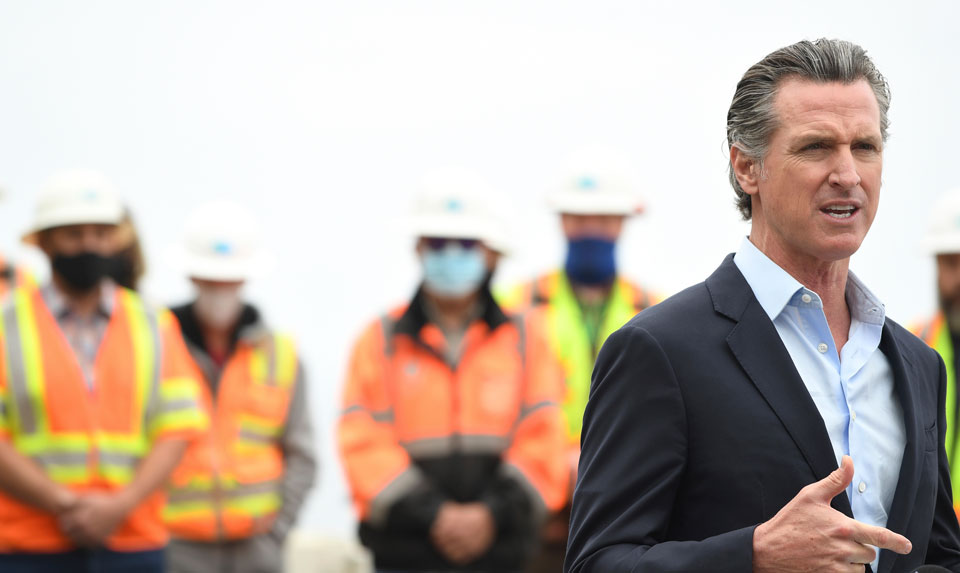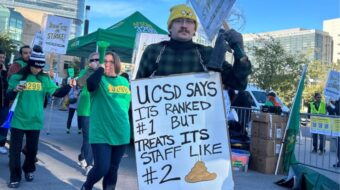
With California’s finances buoyed by unanticipated tax revenues and a $27 billion boost from the American Rescue Plan, Gov. Gavin Newsom on May 14 rolled out a proposed $267.8 billion budget he called “historic” and “transformational,” with infusions of funding for housing, education, healthcare, infrastructure, environmental justice, and immediate relief for families and small businesses.
Incorporating parts of the upcoming 2021-22 budget as well as anticipated spending in future years is the governor’s $100 billion California Comeback Plan, termed “the biggest economic recovery package in California’s history.”
This year’s “May Revise,” updating Newsom’s January budget proposals, reflects an expected $75 billion in tax revenue paid mostly by the state’s high earners. It contrasts sharply with the picture a year ago when in the early months of the COVID-19 pandemic a $54 billion budget hole was projected.
The outstanding news also comes at an opportune time for Newsom, a Democrat, as he fights back against an attempted right-wing recall.
The budget now goes to the state legislature, which has until June 15 to approve a final spending plan for the fiscal year starting July 1. While both Assembly and state Senate boast Democratic supermajorities, legislators have their own priorities, so some sharp debates can be expected along the way.
Among spending priorities:
Housing: Some $12 billion would go toward building affordable housing and taking other steps to house the unhoused, including increasing mental health services. Of that, $7 billion would buy and rehabilitate additional hotels, motels, and vacant apartment buildings to provide unhoused people with interim or permanent housing through Project Homekey.
Another $150 million would stabilize and rehouse people temporarily sheltered under Project Roomkey which provided safe places for unhoused people to quarantine and recuperate from COVID-19, while $1.75 billion would be used to build new affordable homes and nearly half a billion would address student homelessness in the University of California, California State University, and California Community College systems.
Affordable housing organizations praised Newsom’s proposals. Housing California called the governor’s commitment “unprecedented” and said it would lead to “generational benefits for our neighbors who are struggling the most.”
The Nonprofit Housing Association of Northern California applauded Newsom’s “bold leadership” and “historic investment” and urged the legislature “to advance the May Revision while also looking for opportunities to scale.”
Education: Every facet of public education would gain, starting with some $2.7 billion annually to provide a year of transitional kindergarten for all California 4-year-olds. Another $1 billion annually would provide additional after-school and summer programs in low-income communities.
Also funded: youth mental health support; teacher/school worker training; increased staff, including counselors, social workers, and nurses; greater access to school-based nutrition; establishing $500 college savings accounts for students from low-income families, with $500 more for homeless and foster youth.
The cost of attending college would be lowered by drastically cutting the cost of student housing and working to reduce the cost of textbooks, among other measures.
In a statement, California Federation of Teachers President Jeff Freitas applauded Newsom’s proposals, calling them “a bold step forward for our public schools” that will be “critical” to ensure that students can recover and thrive in the wake of the pandemic.
California Teachers Association President E. Toby Boyd said the May Revise represents a “historic commitment to public education.” He commended Newsom’s commitment to early childhood education and transitional kindergarten, and to making college more affordable.
Healthcare: The most striking item in the governor’s healthcare proposals is the allocation of $1 billion annually to make undocumented people aged 60 and older eligible for health coverage under Medi-Cal, the state’s Medicare program. Undocumented youth are already eligible up to age 26. Legislators and public health advocates are urging that all undocumented Californians be made eligible for the program.
The May Revision also proposes expanding Medi-Cal coverage to postpartum individuals, covering doula services under Medi-Cal, and offering subsidized zero-dollar premium plans. But it lacks significant new funds for public health, though the pandemic and other stresses have put major pressure on county health departments.
Anthony Wright, executive director of Health Access California, said while the budget “makes some important investments to expand and improve our health system,” including making undocumented seniors eligible for Medi-Cal, it missed other opportunities to meet urgent ongoing needs. He called on the legislature to take additional steps for a universal health care system, which he called “more urgent than ever post-pandemic.”
Kiran Savage-Sangwan, executive director of the California Pan-Ethnic Health Network, expressed similar concerns, saying, “While there is much to celebrate, we are thoroughly disappointed that there is once again no new state funding for California’s public health departments … We think strong and meaningful investments in addressing racism as a public health crisis and social determinants of health are desperately needed, and CPEHN will work with the legislature to ensure communities of color get the resources they need to thrive.”
Infrastructure, transportation: The California Comeback Plan allocates $7 billion to build out high-quality internet in lower-income urban and rural areas. Local governments and Native American tribes will be able to access last-mile funding to connect broadband to homes.
Also planned:
- $11 billion to create a modern transportation system, modernizing roads, bridges, and public transportation, continue construction for high-speed rail, and build infrastructure in preparation for the 2028 Los Angeles Olympics.
- $3.2 billion to increase zero-emission vehicle use.
- $1.3 billion to prepare for climate change consequences including extreme heat and rising sea levels.
Emergency preparedness: $2 billion is projected for wildfire and emergency preparedness, including purchase of new firefighting equipment, including airplanes and helicopters, and investing in land and forest management projects that help to prevent fires.
Small businesses: $1.5 billion is to provide grants of up to $25,000 for small businesses harmed by the pandemic. A program launched in January has so far helped nearly 200,000 small businesses and nonprofits with grants between $5,000 and $25,000, with a large proportion going to enterprises owned by people of color, women, and veterans, and/or located in low- to moderate-income communities. It is estimated the new allocation could help as many as 150,000 more small businesses.
Individuals: A new round of $600 stimulus checks would build on the checks sent earlier in the year to people making less than $30,000 annually. Now, checks would go to those earning between $30,000 and $75,000 annually, and families with children would receive an additional $500.
Under a $1 billion program, workers laid off during the pandemic could apply for grants to help them train for a new job or start a new business for which they have a license. Workers would be eligible for at least $1,000 and grants would be distributed through California’s higher education system.
Another $1 billion would provide help for Californians struggling to pay overdue water bills.
Reserves: Nor is it assumed that the state’s financial future will always be rosy. Some $24.4 billion would go to bolster the state’s reserve accounts, including the so-called Rainy Day Fund that provides a cushion when revenues fall.










